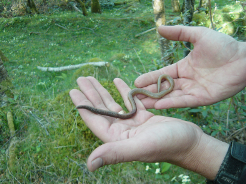
Invasive earthworms
Above An example of Lumbricus terrestris, which is invasive in the United States
The presence of non-native earthworms within the United States has long been recognized, but has received little attention until relatively recently. During the last decade, considerable research has focused on documenting the effects of non-native earthworms. These studies indicate that non-native earthworms can alter soil structure, organic matter content, nutrient dynamics, and plant and animal communities. While it is clear that many non-native earthworm species are widespread and abundant within the United States, their distributions are still poorly known. The aim of this project was to map the range of non-native earthworm species to better understand their distribution and to identify environmental and anthropogenic factors that might enhance or constrain their spread. In addition, this information could be used to identify areas that may be vulnerable to further invasion by non-native earthworm species or more vulnerable to their effects due to sensitive environmental characteristics. As a result of this project, historical distributions of native species were also delineated and with further study one could determine if their ranges have remained stable, expanded or contracted possibly as a result of land use changes or competition from these non-native species.
Methods
First we compiled county level collection records for all species of earthworms known to occur in the United States. Sources used included literature records as well as museum collection data. In all we compiled 12880 records on 129 species of earthworm from all 50 states. Of these 129 species, 46 were non-native. We then used GIS software to create distributional maps for each species from these collection records (Figure 1). All records were mapped on the county level. Despite the widespread coverage, most states were represented with few records. Coverage was generally greater among the eastern states and least among the Great Plains and west. Additional sources are available which when entered will help fill in some of the gaps in our coverage.
Related publications:
- Hendrix P.F., M.A. Callaham Jr., J.M. Drake, C. Huang, S.W. James, B.A. Snyder, and W. Zhang. 2008. Pandora’s box contained bait: the global problem of introduced earthworms. Annual Review of Ecology, Evolution, and Systematics 39: 593-613. [pdf]
The county-level distribution of Lumbricus rubellus, a non-native species, in the United States. Counties filled with black represent locations where this species has been collected. Counties filled with gray represent locations for which we have collection data, but not for this species. Counties that are unfilled represent counties for which we have no data.






